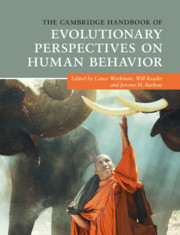Book contents
- The Cambridge Handbook of Evolutionary Perspectives on Human Behavior
- The Cambridge Handbook of Evolutionary Perspectives on Human Behavior
- Copyright page
- Dedication
- Contents
- Figures
- Tables
- Contributors
- Preface
- Acknowledgments
- Part I The Comparative Approach
- 1 Human–Grey Parrot Comparisons in Cognitive Performance
- 2 Cognitive Abilities in Elephants
- 3 Culture and Communication among Cetaceans
- Part II Sociocultural Anthropology and Evolution
- Part III Evolution and Neuroscience
- Part IV Group Living
- Part V Evolution and Cognition
- Part VI Evolution and Development
- Part VII Sexual Selection and Human Sex Differences
- Part VIII Abnormal Behavior and Evolutionary Psychopathology
- Part IX Applying Evolutionary Principles
- Part X Evolution and the Media
- Index
- References
2 - Cognitive Abilities in Elephants
from Part I - The Comparative Approach
Published online by Cambridge University Press: 02 March 2020
- The Cambridge Handbook of Evolutionary Perspectives on Human Behavior
- The Cambridge Handbook of Evolutionary Perspectives on Human Behavior
- Copyright page
- Dedication
- Contents
- Figures
- Tables
- Contributors
- Preface
- Acknowledgments
- Part I The Comparative Approach
- 1 Human–Grey Parrot Comparisons in Cognitive Performance
- 2 Cognitive Abilities in Elephants
- 3 Culture and Communication among Cetaceans
- Part II Sociocultural Anthropology and Evolution
- Part III Evolution and Neuroscience
- Part IV Group Living
- Part V Evolution and Cognition
- Part VI Evolution and Development
- Part VII Sexual Selection and Human Sex Differences
- Part VIII Abnormal Behavior and Evolutionary Psychopathology
- Part IX Applying Evolutionary Principles
- Part X Evolution and the Media
- Index
- References
Summary
Everybody knows elephants are intelligent – everybody, that is, except for evolutionary psychologists. The popular characterization of these large, long-lived, very social mammals is that they have fantastic memories and are considered somehow “special,” but the scientific evidence behind this reputation is somewhat lacking, with there having been relatively few attempts to study elephant cognition during the twentieth century. Fewer than 20 manuscripts detailing novel studies of elephant cognitive abilities had been published by the end of the first decade of this millennium (Byrne, Bates, & Moss, 2009), though a gradually increasing research effort is now resulting in progress.
So why, as psychologists, are we even interested in elephants, animals with which we have not shared a common ancestor for around 105 million years (Hedges, 2001; Murphy et al., 2001)?
- Type
- Chapter
- Information
- Publisher: Cambridge University PressPrint publication year: 2020



